What is Textured Leather: Meaning & Applications
One of the most common ways of identifying leather is by feeling its texture, which ranges from smooth to incredibly rugged. It’s important to identify the different types of leather textures because the suitability of leather for a given purpose is determined by its texture.
Therefore, in this article, we’ll define “textured leather,” list the various kinds of leather textures, and discuss each of their applications.

What is textured leather?
Textured leather simply means leather that has been artificially enhanced to have a gritty rough texture on the surface. This is attained during the tanning process where a texture press machine is used to give the leather a stamped, grainy, or embossed feel.
Leather texture types
There are several different types of leather textures such as smooth leather, pebbled leather, grainy leather, flat grain leather, and embossed leather.
1. Smooth texture
Smooth texture leather as the name suggests feels smooth on the surface.
The smooth texture is achieved by buffing the surface of the leather to a shine. Additionally, to produce a softer, suppler feel and a surface with a finer grain, the top layer of the hide is shrunk, sanded, and polished.
One benefit of the smooth finish is that it makes the leather more resistant to moisture. However, on the downside, the smooth surface makes the leather more prone to scratches and tears.
The smooth leather texture is mainly used to make belts, shoes, boots, and purses, as it gives them a sleek and polished look.
It is also used on clothing items such as gloves or jackets as it makes them more pleasant to wear.
2. Embossed leather texture
Leather that has been imprinted or stamped with a pattern or design is called embossed leather.
The pattern might be anything from a straightforward geometric shape to an intricately detailed design such as those seen on Louis Vuitton animal leather bags.
The embossing procedure is done on natural grain animal leather by stamping it with steel engraved plates under high heat and pressure. This leaves the leather with a raised surface that gives it a three-dimensional pattern and rough texture.
As a result of its opulent appearance and feel, leather that has an embossed texture is frequently used to create furniture, including sofas and chairs.
Bags and wallets are also made from this kind of leather.
3. Flat grain texture
Flat grain leather is a kind of leather that has been tanned to provide an extremely smooth surface with a visible grain.
The texture is produced by tanning the hide with a substance that causes the skin’s collagen strands to break down.
This leaves a thin layer of leather that is evenly spread throughout the hide’s surface.
Because of its sleek, smooth, and lux appearance, this flat grain leather is frequently used to create the highest quality upholstery.
4. Pebble leather texture
Pebble grain leather has a raised stamped surface that resembles small stones or pebbles.
This bumpy texture is achieved through a special tanning procedure that leaves the leather’s surface covered in tiny, raised bumps, giving it a pebbled feel.
As a result, the leather has a unique appearance and feel and is more resistant to stains and scratches.
But basically, pebble grain leather is a popular choice for luxury items because of its high level of durability and style.
5. Grainy leather texture
Grainy leather is produced by pressing the hide while it’s wet or damp, giving it a coarse sensation. This results in the leather’s fibers separating and creating a “grainy” texture on the surface of the leather.
You can actually feel the rough, bumpy texture when you run your fingers over the surface of the grainy leather.
Is textured leather real leather?
Yes, it is real leather that is treated during the tanning process to give it a textured surface.
As we have already stated above, the textured surface can be obtained by stamping, embossing, or pressing on any type of natural leather under high heat and pressure.
Textured vs Smooth leather
Leather that has been finished with a textured surface compares to smooth leather in that it hides imperfections and inconsistencies in natural leather.
In addition, it is more durable since it doesn’t show scratches easily because texturing leather protects it from wear and tear.
Smooth leather on the other hand may show imperfections on natural leather so the products may not have a very seamless look.
Additionally, smooth leather tends to wear out easily and the stains, scratches, and scuffs are difficult to hide. Also, it gets creased and wrinkled over time because it is not very sturdy.
Conclusion
Leather in its original form is not very attractive. So to enhance its appearance, leather is textured by embossing, pressing, or stamping to create an attractive pattern or design on the surface.
This results in different types of leather textures such as embossed, pebbled, grainy, smooth, or flat textures.
Texturing leather is also important in that it not only hides the imperfections found in natural leather but also makes it more durable.
Moreover, it produces a wide variety of leather that can be used to make different and more attractive leather items like shoes, wallets, clothes, and bags.





